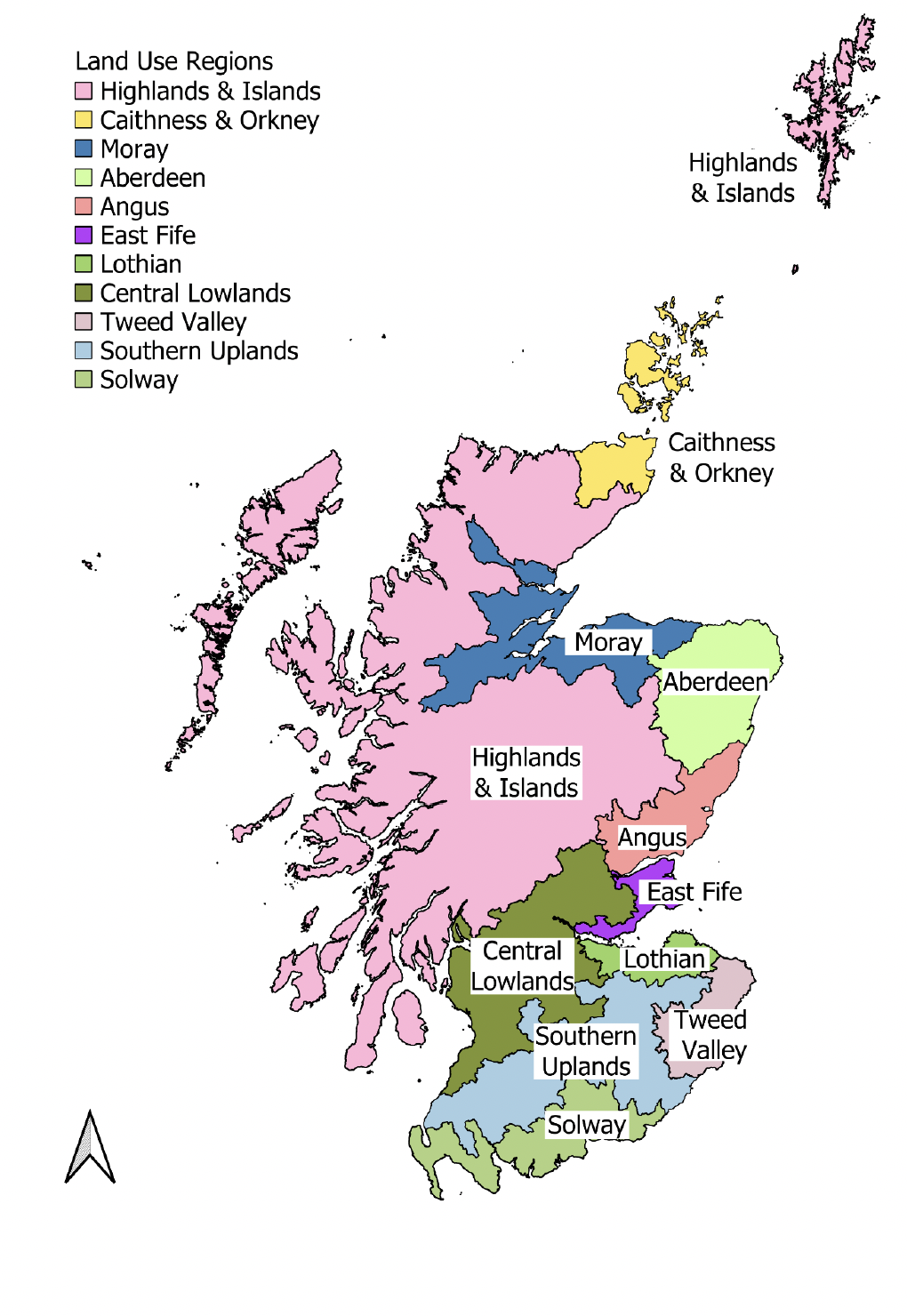Pesticide Usage in Scotland: Arable crops and Potato stores 2022
This publication presents information from a survey of pesticide use on Arable crops and Potato stores in Scotland during 2022.
Appendix 4 – Survey methodology
Sampling and data collection
Using the May 2022 Single Application Form (SAF) data,a sample was drawn representing arable cultivation in Scotland. The country was divided into 11 land-use regions (Figure 7). Each sample was stratified by these land-use regions and according to holding size. The holding size groups were based on the total area of arable crops grown. The sampling fractions used within both regions and size groups were based on the areas of relevant crops grown rather than number of holdings, so that smaller holdings would not dominate the sample.
Data relating to pesticide use in potato stores were collected from all potato growers encountered in the arable sample, either during an on-farm or telephone interview, or via e-mail. In instances where the potato land was let, and storage was on a separate holding, the potato grower was contacted individually to obtain storage details. Data were collected for all potatoes stored by these growers, not just for those crops grown on the holdings sampled. Therefore, the sample of stored potatoes relates to a greater area of potato cultivation than that for which field pesticide treatments were collected in the 2022 arable pesticide survey report. In total, data were collected from 73 growers. The crops grown by these growers represent 28 per cent of the total 2022 potato crop SAF area.
The data collected included the areas of seed and ware crops grown, quantities of potatoes sold and stored, storage type, storage method and post-harvest pesticide applications at crop lifting and during storage. Fungicidal seed treatments applied prior to planting are included in the arable crop report.
Raising factors
National pesticide use was estimated by ratio raising. This is a standard statistical technique for producing estimates from a sample. It is the same methodology used by the other UK survey teams and has been used for all historical datasets produced by the Pesticide Survey Unit, allowing comparability over time. The sample data were multiplied by raising factors (Table 10). These factors were calculated by comparing the sample area to the areas recorded in the May 2022 SAF data within each region and size group (please see changes from previous years section for further detail). An adjustment (Table 11) was made to the ware fraction to correct for the potatoes grown as seed that were then designated as ware. A second adjustment (Table 12) was made to align the survey estimates of total tonnes stored with the estimated tonnage of Scottish potato stocks held in store at the end of November provided by SASA Potato section. This represents a change in methodology from previous surveys (see next section).
Due to the low numbers of potatoes grown and sampled in some geographic regions, stored data were amalgamated into four regions to allow more robust estimation of pesticide use: the North (Highlands & Islands, Caithness & Orkney, Moray Firth and Aberdeen), Angus (the main potato growing area in Scotland), Central (East Fife, Lothian, and Central Lowlands) and the South (Tweed Valley, Southern Uplands, and Solway).
Changes from previous years
There are a number of changes which should be noted when comparing the 2022 data with the previous survey.
For previous reports, the June Agricultural Census was used to draw a sample of farmers growing the relevant crops to participate in the survey. National pesticide use was then estimated by ratio raising, by comparing the sample area to the areas recorded in the June Agricultural Census data.
To allow for the Agricultural Statistics Transformation Programme(11), the June 2022 Agricultural Census was paused. This pause was agreed with the Office for Statistical Regulation and data users.
For this report, the May 2022 Single Application Form (SAF) data was used to draw the sample and estimate national pesticide use using the same methodology as previous surveys. SAF data accounts for the majority of land area for arable crops. The sample drawn is based on area of crop grown, rather than number of holdings. As such, no attempt is made to account for holdings that are not captured by SAF returns.
There has been a further significant change in the raising process. During the statistical estimation of national pesticide use on stored crops from the sample surveyed (see raising factor section), an adjustment is made to align the survey estimates of total tonnes stored with production estimates previously provided by AHDB Potatoes. All market intelligence work by AHDB potatoes ceased from July 2021, therefore this data was no longer available. Instead, in 2022, production and storage figures were obtained using data provided by the SASA potato department and the Seed Potato Classification Scheme. It was estimated that 80 per cent of the seed and ware potatoes produced in Scotland were still in storage at the end of November 2022.
There was also a significant change in the statistical estimation of national pesticide use on stored crops from the sample surveyed between 2018 and 2020. Please refer to the 2020 report for a full explanation. The 2020 report published a correction to the 2018 storage methods using the new method. The 2020 and updated 2018 figures from the 2020 report have been included in this report for comparison purposes.

Contact
Email: psu@sasa.gov.scot
There is a problem
Thanks for your feedback